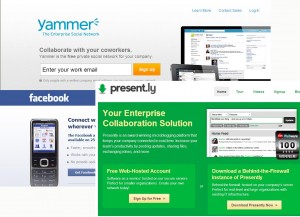I’ve been thinking a lot about Intranets this year. The question is coming up more frequently with clients as to how to use Intranets to lower costs, and improve employee engagement; and the one word which keeps coming up in one form or another is Collaboration. How do you get turn your Intranet into a tool which employees both want and need to use on a daily basis, and one which they use for working with other employees?

Collaboration seems to have been the buzz word of 2011. Much in the same way that Social Media has really taken off and become a key tool for businesses to talk to their customers, it seems that Social Media type tools are being increasingly used to engage and communicate with staff. Bulletin board and twitter style update tools that spring to mind which are focussing on this niche are yammer and present.ly but it still seems to me that these one-line Facebook style updates provide just one channel and you can’t rely on all employees wanting to to engage in this way. Often they will be trying to find or communicate information regarding policies or procedures which are better housed in a document library or sent only to certain individuals.
Back in 2001 I worked with Phones4u when John Caudwell hit the news for banning email. I have no idea if he was the first big business man to hit upon this concept, and he certainly hasn’t been the last – in fact Atos recently declared a ban on all internal emails. In principle there is a sound argument that emails are distracting, prevent people from doing their day to day job, and that people overly rely on it for all communications, when often picking up the phone and talking is a far better way to get a resolution. However in truth, like with bulletin or discussion boards this is only one channel and it is about using it in the correct way. Email is a very efficient tool for confirming actions & minutes, sending contracts & agreements or providing notifications of events. Where email fails it is frequently because it is being used instead of conversation. The Inbox fills up and the important notifications get missed. However, in today’s world of overcrowded diaries, flexible hours and working in different locations and different time zones, an alternative mechanism for conversation than face to face meetings is still required.
For the past decade or so I think it’s fair to say that Intranets have most commonly been used as a broadcasting tool and document repository; with sales messages, staff policies, organisation charts, structure changes and staff bulletins being the key purpose of the site. Unfortunately over time many Intranets have become clogged with information, with fewer people keeping them up to date and relevant information becoming increasingly more difficult to find. More recently Intranets have been plugged into more interactive tools such as HR systems, time management systems or Management Information Systems. However there was still largely a disparity between the types of interaction: interaction between users and Intranet tools, and interaction between multiple users.
Increasingly though organisations are spotting this gap. The fact that employees are having to move between email, Intranets and various interactive tools is being seen as a barrier to efficiency; and so there is a desire to bring the systems together and the line between which mechanism to use when is becoming increasingly blurred. When you look at systems such as IBMs Connections software which links email to a social media type interactive bulletin/discussion board, and can also host content managed web copy and documents or when you look at the various ways you can use Sharepoint tas a web publishing tool for both pages and documents, and where you can not only publish documents but feedback on them and introduce version control – then you start to realise how joined up Intranets could really become.
It is great to see more organisations looking to technology to improve efficiencies in this way. Too often I think Intranet projects are given lower priority as they are not seen to bring in the value to organisations that more commercial e-commerce based web projects could bring. However I do think that before any business embarks on this road it’s important that they go back to basics and identify the key requirements:
- Who do staff need to communicate/interact with to do their day to day job?
- What tools do staff need to do their day to day job?
- What information does staff need to do their day to day job?
- How are you going to train staff as to which elements to use for which types of communication and then ensure a culture of correct use is followed?
If you start to get too carried away with the technology, or don’t invest the time and therefore forget to ask these key areas, then I fear that no matter what solution is put in place it will ultimately grow into another example of an Intranet which ultimately is undervalued.
